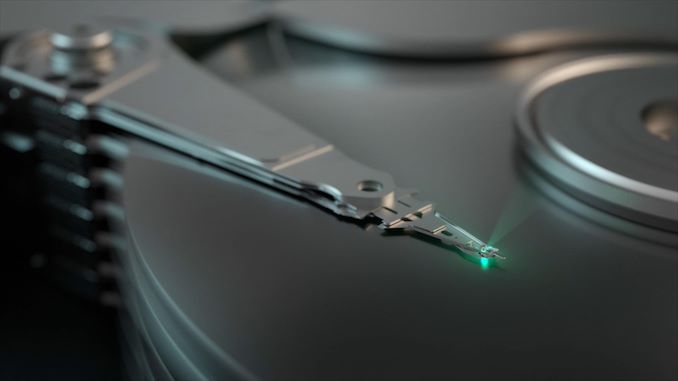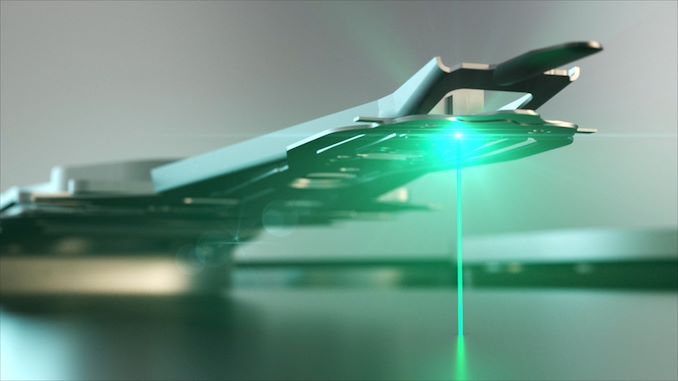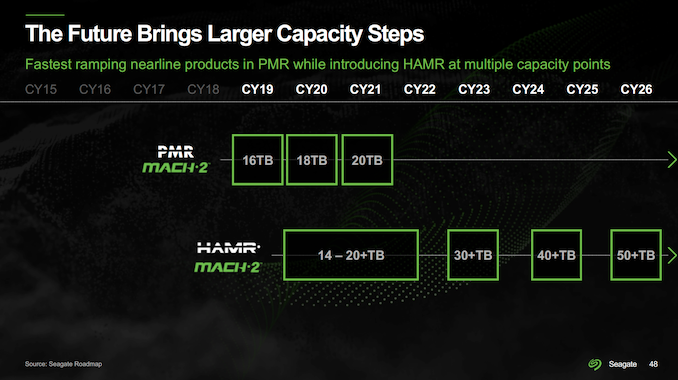Seagate Confirms 30TB+ HAMR HDDs in Q3, Envisions 50TB Drives in a Few Years
by Anton Shilov on January 27, 2023 6:00 PM EST
Seagate this week confirmed plans to launch the industry's first 30+ TB hard drive that uses its heat assisted magnetic recording (HAMR) technology, as well as reaffirming its commitment to release HDDs with capacities of 50 TB and higher in a few years. But before this happens, the company will release 22 TB and 24 TB HDDs that will rely on perpendicular magnetic recording (PMR) and shingled magnetic recording (SMR) technologies, respectively.
One More Play for PMR and SMR
Various energy assisted magnetic recording methods, such as HAMR, will be used for next generations of hard drives for years to come. But while PMR is running out of steam, it is still evolving. Seagate has managed to increase areal density enabled by its PMR + TDMR platform by around 10%, enabling 2.2 TB 3.5-inch HDD platters and thus 22 TB hard drives featuring 10 of such disks. Furthermore, by using shingled recording, these drives can have their capacity stretched to 24 TB.
These 22 TB and 24 TB Seagate Exos drives will likely be drop-in compatible with existing cloud datacenter hardware as well as infrastructure, and should not require extensive validation and certification procedures, unlike brand-new HAMR HDDs. As a result, Seagate's customers will be able to deploy such hard drives fairly quickly and increase storage density and storage capacity of their datacenters.
Seagate is now ramping up production of its 22 TB hard drives for datacenters, so expect the company to start their shipments shortly. Seagate is not disclosing when exactly it will officially launch its 22 TB and 24 TB parts, but we would expect them to arrive before the company introduces its HAMR-based HDDs; so think Q1 or Q2.
30+ TB HDDs Coming in Q3
In fact, Seagate has been shipping HAMR HDDs to select customers for evaluation as well as inside its own Lyve storage systems for a while, but those drives featured capacities akin to those of PMR/CMR HDDs and were not available in huge volumes. With Seagate's 2nd generation HAMR platform, the company is going after higher volumes, but it took the company quite some time to get there. The first pre-qualification high-capacity HAMR-based HDDs are only just now getting ready to head out to customers for evaluation.
"We are meeting or exceeding all product development milestones and reliability metrics, and we will be shipping pre-qualification units to key cloud customers in the coming weeks," said Dave Mosley, chief executive of Seagate.
Meanwhile, commercial HAMR hard drives with capacities of 30TB or higher will ship in third quarter of this year, which is in-line with what Seagate promised last year.
"As a result of this progress, we now expect to launch our 30-plus terabyte platform in the June quarter, slightly ahead of schedule," said Mosley. "The speed of the initial HAMR volume ramp will depend on a number of factors, including product yields and customer qualification timelines."
Initially Seagate will only offer its HAMR technology for its highest-capacity offerings for hyperscale datacenters, whom need maximum storage density and are willing to pay premium for the drives and for supporting infrastructure. As yields of HAMR-supporting media and the appropriate read/write heads increase, the technology will be applied for drives with lower capacities in a bid to cut down their production costs (fewer disks and heads, lower the costs). This is not going to happen overnight though, as the company needs to increase yields of HAMR drive components and the HDDs themselves to a comfortable level.
"I think this year, [the volume of HAMR HDDs] will probably still be relatively low," said the head of Seagate. "Then the faster we can get the yields and scrap and all the costs that we can control down on the heads and media, then the faster we'll be accelerating. I think that will happen in calendar year 2024 and calendar year 2025 will just continue to accelerate. The highest capacity points will be addressed, but also these midrange capacity points."
50+ TB HDDs Will Be Here in a Few Years
Seagate's launch of its first mass market 30+ TB HAMR hard drives platform will mark a milestone for the company and the whole industry. But apparently the company has another breakthrough to share at this time. The firm said this week that it had created 5 TB platters for 3.5-inch hard drives, which presumably entails new media, new write heads, and new read heads.
"It was nearly four years ago to the day that I first shared our lab results demonstrating 3 TB per disk capacities," explained Mosley. "And today, we have demonstrated capacities of 5 TB per disk in our recording physics labs."
For now, these platters are used on spinstands for evaluation and testing purposes, but platters like these will allow for 50 TB HDDs a few years down the line. Seagate's roadmap indicates that such hard drives will hit the market sometimes in calendar 2026.
It is unclear how thin the new platters are. But following current trends of nearline HDD evolution — increasing areal density and increasing number of platters per hard drive — it's not outside the realm of possibility that Seagate will find ways to integrate even more than 10 platters in future drives. In which case Seagate would be able to hit drive sizes even larger than 50 TB.
In any case, with ~3 TB platters in production, samples of ~30 TB HDDs shipping to customers, and 5 TB platters demonstrated in the lab, Seagate's HAMR roadmap seems to look quite solid. Therefore, expect hard drives to gain capacities rapidly in the coming years.












70 Comments
View All Comments
boozed - Friday, January 27, 2023 - link
Ahh the new Anandtech recommended consumer drives!ads295 - Tuesday, January 31, 2023 - link
Good one."Looking for a hard drive? Well of course you need 30TB of space."
FunBunny2 - Wednesday, February 1, 2023 - link
"Looking for a hard drive? Well of course you need 30TB of space."c'mon man!! nobody needs more than 640K.
HarryVoyager - Tuesday, February 14, 2023 - link
Don't worry. I'm sure it won't me more than a year or two before the latest AAA games are pushing 10TB before DLC.If you build it, they will fill it!
PeachNCream - Saturday, February 4, 2023 - link
Don't forget all recommendations will be supported by viewing manufacturer specs and absent of any review efforts, but those links to Amazon product pages will have sponsor kickbacks.The Von Matrices - Friday, January 27, 2023 - link
The only advantage hard drives hold over solid state media is cost per capacity, so that is the only metric that matters. Adding so much new technology surely has to increase the manufacturing cost, so capacity has to increase significantly to justify the price increase. Unless you're in a situation where you absolutely cannot add a few additional disks I don't see any reason to buy the first production widely available HAMR disks. It will take until the 40TB generation until HAMR beats CMR in cost/capacity and I actually consider buying one.I'm also waiting to hear about the maximum number of program/erase cycles on these HAMR disks. That detail seems curiously absent from any press releases.
StevoLincolnite - Friday, January 27, 2023 - link
Pretty sure mechanical drives are better for archival purposes as well... Where NAND will bit flip and loose data over time.The Von Matrices - Friday, January 27, 2023 - link
My experience with hard drives has been that the helium hard drives aren't perfect for long-term cold storage either - you still need to verify them every few months or so because I've had a few that slowly leak helium. Sure, since the data isn't affected when the helium leaks you could send it to a disaster recovery service and they could get all the data back but that's expensive. Tape backup seems to be the only safe option for long-term cold storage.nandnandnand - Saturday, January 28, 2023 - link
Is it necessarily a failure if all helium leaks out of a drive, or could it run at a lower RPM (long enough for the whole drive to be copied)?The Von Matrices - Tuesday, January 31, 2023 - link
I'm not familiar enough with fluid dynamics to give an informed answer. The helium has a thinner boundary layer than air allowing the heads to be closer to the platters, so if air replaced the helium, the heads would be too far away from the platter to read anything, but I'm not sure how the rotation speed affects the thickness of the boundary layer.